Gone are those days of traveling to the office and sitting in a cubicle for 8 hours to get your work done.
Most of the organizations in the world rely on remote work from home, and employees have now adapted adequately to this new normal of work culture.
Every organization strives to monitor its employee’s performance and implement performance reviews. To improve the productivity and implementation of a remote team, managers need to communicate with them effectively.
Managing a remote team is always challenging, but we can lead a remote team efficiently and bring out exceptional job performances with precise planning and communication. Here is a complete guide for remote team management in 2024.
Table of Contents
Unlock the full potential of your remote team with Teamflect!
Use Teamflect, the ultimate performance management software designed for Microsoft Teams to unlock the full potential of your remote team. Enhance communication, track progress, and foster a culture of excellence.
Don’t let distance be a barrier to exceptional teamwork. Improve your remote team’s performance with Teamflect. Explore our solution now and transform the way you manage and engage with your remote workforce.



